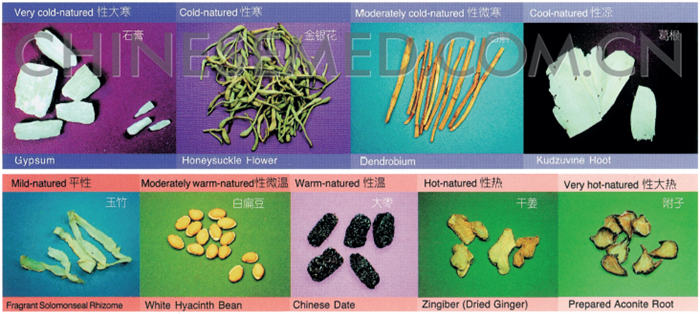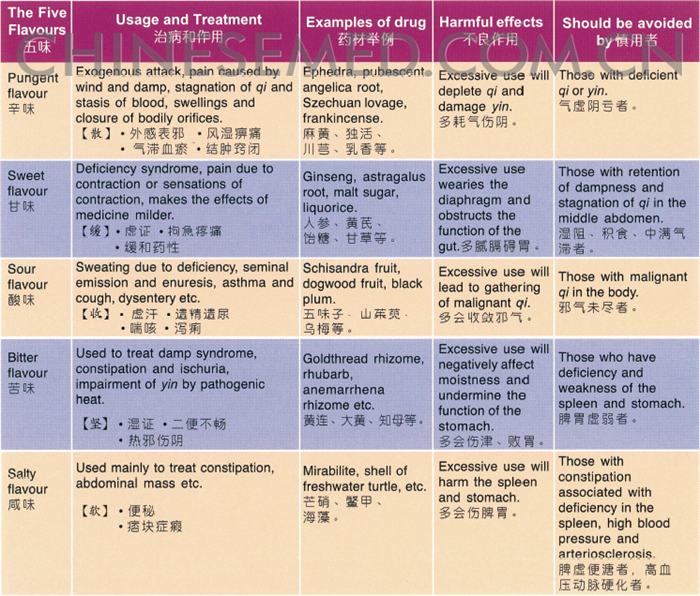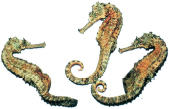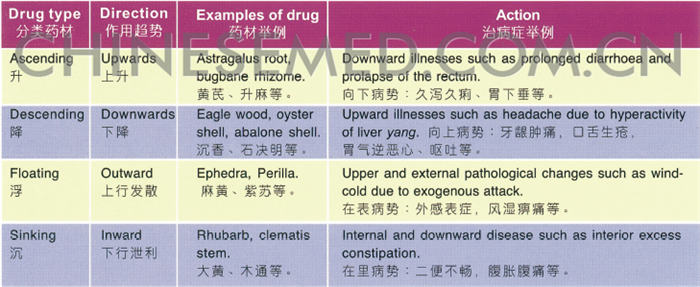Si qi wu wei  refers to the four properties and five flavours of Chinese medicines.Gui jing
refers to the four properties and five flavours of Chinese medicines.Gui jing  refers to the function of Chinese medicines, andsheng jiang fu chen
refers to the function of Chinese medicines, andsheng jiang fu chen  refers to the direction where the drugs are taking effects.
refers to the direction where the drugs are taking effects.
Four properties (si qi  )
)
This refers to the four properties of Chinese medicines. Known also assi xing  , they are the cold, hot, warm and cool nature of medicines. Besides the four properties, there is also mild nature (ping xing
, they are the cold, hot, warm and cool nature of medicines. Besides the four properties, there is also mild nature (ping xing  ), a term used when it is unclear whether the medicine has a cold, hot, warm or cool nature, or if it has a mild effect.
), a term used when it is unclear whether the medicine has a cold, hot, warm or cool nature, or if it has a mild effect.
- “Cool medicines”: used for clearing away heat, purging fire, detoxifying and nourishingyin. E.g. gypsum
 , honeysuckle flower
, honeysuckle flower  , goldthread rhizome
, goldthread rhizome  , ophiopogon root
, ophiopogon root  , etc.
, etc. - “Mild medicines”: refers to medicinal materials of mild properties that are warm but not dry, cool but not cold. E.g. pilose asiabell root
 , bupleurum root
, bupleurum root  , etc.
, etc. - “Warm-heat medicines”: used for expelling cold, clearing blood vessels, invigoratingyang andqi. E.g. prepared aconite branch-root
 , evodia fruit
, evodia fruit  , astragalus root
, astragalus root  , Korean ginseng
, Korean ginseng  , etc.
, etc.
The Four Properties

Five flavours (wu wei  )
)
This refers to the authentic flavour of the medicine and food. Also known as the tastes of Chinese medicines, they include sour, bitter, sweet, pungent and salty, which are the five basic flavours. They are usually called “the five flavours of medicines”. Actually, there are more than five flavours of medicines and food, e.g. mild-flavoured, and astringent. The latter is classified as a sour flavour, while the former is considered to be a type of sweet flavour.

The Five Flavours

Fast facts
About the “five properties (wuxing )
Li Shizhen  was the person who first mentioned the “five properties (wuxing
was the person who first mentioned the “five properties (wuxing  )” of Chinese medicines, namely the cold, hot, warm, cool and mild natures. As the mild property is considered to be subjective, the term “four properties (siqi
)” of Chinese medicines, namely the cold, hot, warm, cool and mild natures. As the mild property is considered to be subjective, the term “four properties (siqi  )” has been used in the pharmaceutical field to the present day.
)” has been used in the pharmaceutical field to the present day.
Meridian tropism (gui jing  )
)
The meridians through which the therapeutic action of drugs is manifested. This is known as meridian tropism (gui jing  ). Gui
). Gui  is the classification of drugs according to their effects. Jing
is the classification of drugs according to their effects. Jing  is a general term used to refer to the meridians of organ systems. With the knowledge of meridian tropism, we are able to identify the exact therapeutic effects a Chinese medicine has on specific internal organs and meridians. Thus, we can choose to use certain Chinese medicines to treat pathological changes in a specific body part, bringing about main and specialised therapeutic effects. The therapeutic effects of medicines differ with different meridians. The understanding ofgui Jing
is a general term used to refer to the meridians of organ systems. With the knowledge of meridian tropism, we are able to identify the exact therapeutic effects a Chinese medicine has on specific internal organs and meridians. Thus, we can choose to use certain Chinese medicines to treat pathological changes in a specific body part, bringing about main and specialised therapeutic effects. The therapeutic effects of medicines differ with different meridians. The understanding ofgui Jing  thus enables us to improve the accuracy with which we apply medicines.
thus enables us to improve the accuracy with which we apply medicines.

Direction of medicinal action (sheng jiang fu chen  )
)
This refers to the direction of the action of drugs.
Sheng  , which means ascending, refers to drugs with an upward effect, used to treat illness of descending condition.Jiang
, which means ascending, refers to drugs with an upward effect, used to treat illness of descending condition.Jiang  , which means descending, refers to drugs with a downward effect to treat illness of ascending condition.Fu
, which means descending, refers to drugs with a downward effect to treat illness of ascending condition.Fu  , which means floating, refers to drugs which have an outward effect to cure external illness.Chen
, which means floating, refers to drugs which have an outward effect to cure external illness.Chen  , which means sinking, refers to drugs having an inward effect to cure internal sickness.
, which means sinking, refers to drugs having an inward effect to cure internal sickness.
The Direction of Medicinal Action

Fast facts
“Meridian guiding action  ” or “herbs for meridian guiding
” or “herbs for meridian guiding  ”
”
Chinese medicinal materials seldom belong to only a single classification, e.g. pilose asiabell root  grouped under both the spleen and lung meridians. This implies that the herb can replenish both lung and spleenqi. Liquorice
grouped under both the spleen and lung meridians. This implies that the herb can replenish both lung and spleenqi. Liquorice  and prepared aconite branch-root
and prepared aconite branch-root  are able to pass through 12 meridians. Yet other Chinese medicines are not classified under any meridian, but can guide other medicinal materials to enter certain meridians. These herbs are called “herbs for meridian guiding(yin jing yao
are able to pass through 12 meridians. Yet other Chinese medicines are not classified under any meridian, but can guide other medicinal materials to enter certain meridians. These herbs are called “herbs for meridian guiding(yin jing yao  )”. E.g. achyranthes root
)”. E.g. achyranthes root  can guide medicines downwards, and cinnamon twig
can guide medicines downwards, and cinnamon twig  can guide medicines into the heart meridian.
can guide medicines into the heart meridian.

